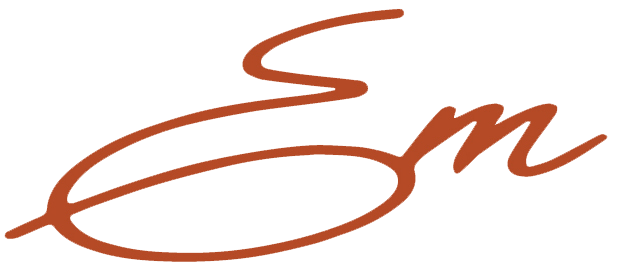For food lovers, only some destinations can compare to Morocco. The country is a veritable feast for the senses with its vibrant colors and exotic spices. But, when it comes to Moroccan cuisine, the flavor is king. From the humble Tagine to the ubiquitous Couscous, each dish is an explosion of taste that will leave you wanting more. So if you’re looking for a culinary adventure, there’s no better place than Morocco. Bon appétit!
From a travel perspective, Morocco is an absolute gem. Year after year, it’s one of the most sought-after destinations in Africa – and for a good reason! But, of course, no trip to this North African paradise would be complete without sampling its culinary delights; locals boast delectable dishes that will have your taste buds singing with joy!
If you enjoy experiencing different cultures through their food, then make sure to try these 30 traditional Moroccan dishes on your next trip! They offer a delicious and authentic way to learn about the local customs and history.
Traditional Moroccan food
Moroccan food is a delicious blend of many different cultures. With influences from Berber, Andalusian and Mediterranean cuisines, as well as European and sub-Saharan flavors, there’s something for everyone to enjoy.
The staple grain in Morocco is wheat. However, common meats include beef, lamb, goat, mutton, and chicken. Seafood is also popular in this North African country. Dishes are often seasoned with preserved lemon, smen (fermented butter), argan oil, olive oil, and dried fruits like apricots or dates. Herbs and spices give these meals an extra zing!
Like in India, spices are used extensively in Moroccan cuisine to give dishes an intense flavor. Some of the most commonly used herbs include cumin, turmeric, cinnamon, saffron, nutmeg, paprika, ginger, and fenugreek. Ras el Hanout is a popular choice with up to 40 different spices.
With so many flavorsome spices and fresh herbs used in Moroccan recipes, it’s impossible not to think of mouthwatering Moroccan food when you think of flavor!
What are Morocco’s most popular dishes?
Moroccan Soups, starters & sides
-
Couscous
What better way to start your Moroccan culinary journey than with Couscous, the nation’s staple dish? Couscous is a widely consumed Maghrebi dish made of small durum wheat semolina granules.
Currently, the fabrication of Couscous is, for the most part, automated. Still, it’s typically made by showering semolina with water and rolling it by hand to shape little pellets. The pellets are then aspersed with flour to keep them independent before being strained. Finally, any pellets that drop through are rolled once more until they reach the desired size.
Even though you might imagine that the traditional preparation of Couscous is labor-intensive, it is relatively easy. Groups work together to create large batches that would last for months, but the process is relatively quick. The best way to make Couscous is by forming the balls and leaving them out to dry in the sun. This method results in a tastier, more flavorful couscous. Then, when you’re ready to eat it, steam the Couscous and rehydrate it in a Couscousiere until it reaches the desired consistency. This dish is definitely worth the effort!

Couscous is an ideal meal for a communal feast. It’s best served in earthenware dishes, with flavorful stews spooned over the top. Those hosting dinner are encouraged to provide their most esteemed guests with generous servings of meat – ensuring everyone has enough food directly in front of them when it comes time to eat! An enjoyable experience ensues as people gather at the plate and savor its tantalizing contents together.
In Moroccan culture, people only use their right hand to eat. The left hand is considered unclean and is only used to pick up bread or to pass dishes to other guests.
If you want to enjoy Couscous the way it was meant to be eaten, use only your thumb and first two fingers. Gathering it any other way is considered gluttony in Moroccan culture. So no matter how good the Couscous is, resist the urge to stuff yourself – remember, less is more.
You should try Couscous on a Friday! It’s a traditional dish in Morocco, and Friday is the perfect day to enjoy it. That’s because it’s the Muslim equivalent of Sunday, and families usually sit down to a large couscous meal after prayers. The Couscous is traditionally served with a stew made of seven different vegetables, including eggplant, carrots, zucchini, pumpkin, parsnips, tomatoes, and cabbage. Yum!
-
Harira Soup
Entice your taste buds with this zesty Moroccan-inspired concoction of lentils and chickpeas! Harira is a delicacy that can be enjoyed anytime in the year. Still, it’s especially sought after during Ramadan when people break their fasts. This flavourful soup will tantalize all who sample its vibrant tomato base – an unforgettable experience for sure!
This savory and tasty soup called Harira is an ancient recipe passed down through generations of cooks. It typically consists of succulent tomatoes, hearty chickpeas, toothsome lentils, tender onions, fluffy rice, or noodle-like vermicelli noodles combined with eggs to give it a velvety look.
Adding beef, lamb, or chicken can enhance this soup’s stock. However, these ingredients can be left out entirely to make a pure vegetarian version of the soup. To bulk it out, rice or vermicelli are often added as fillers; common seasonings include cilantro, parsley, ginger, cinnamon, and turmeric.
As described, Harira is one of the essential dishes served for Ramadan iftar, the evening meal that breaks the fast. Like Chebakia (a Moroccan pastry), it’s done almost daily in every Moroccan household during Ramadan.

-
Bissara
Bissara is a thick and hearty soup or dip typically enjoyed during the winter months in Morocco. It is made by simmering split fava beans or peas with cumin, garlic, cayenne, paprika, pepper, and olive oil before puréeing them to a smooth consistency. Depending on its thickness, bissara can be enjoyed as a soup or a dip with crusty Moroccan bread. This delicious and comforting dish is often sold as street food in Morocco.

-
Shakshuka
Shakshuka, or shakshouka, is a delicious Mediterranean breakfast dish of poached eggs cooked in a flavorful tomato sauce with garlic, peppers, onions, olive oil, and spices. It’s famous throughout North Africa and the Middle East, and its name translates to “mixture.” This dish is believed to be either Tunisian or Yemeni in origin. Breakfast, lunch, or dinner – Shakshuka is always a great choice! It’s packed with flavor and nutrients to give you the energy you need to power through your day.
Shakshuka is a delicious and versatile one-pan dish that can be customized to your liking. It’s typically made with poached eggs, but you could also use scrambled eggs. There are many different ways to make shakshuka, so feel free to experiment with other spices and ingredients until you find a recipe you love. Typical herbs used in shakshuka include ground coriander, paprika, cumin, and cayenne pepper. Some other delicious additions could be preserved lemon, sheep milk cheese, olives, Harissa, sausage, or minced lamb. So what are you waiting for? Give shakshuka a try today!
Shakshuka is best served fresh and hot in the pan cooked in. Crusty Moroccan bread is the perfect accompaniment for dipping into the rich tomato sauce and runny poached egg.
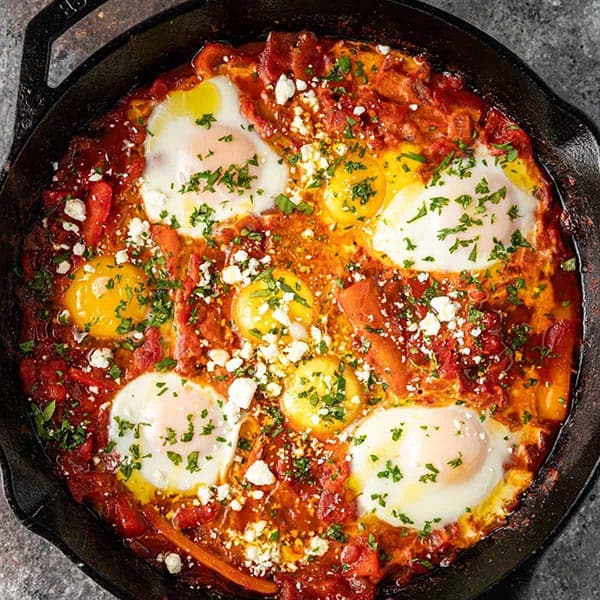
-
Taktouka
Compared to shakshuka, Taktouka is a Moroccan salad composed of tomatoes, roasted bell peppers, olive oil, paprika, and fresh parsley. It has a milder flavor than the popular egg-based dish as it lacks sauces but retains all its deliciousness! This side dish can be served alongside grilled meats or fish dishes or even enjoyed as an appetizer when paired with freshly baked bread. Taktouka also makes for the perfect breakfast alternative if you want to change your morning routine – try it today!
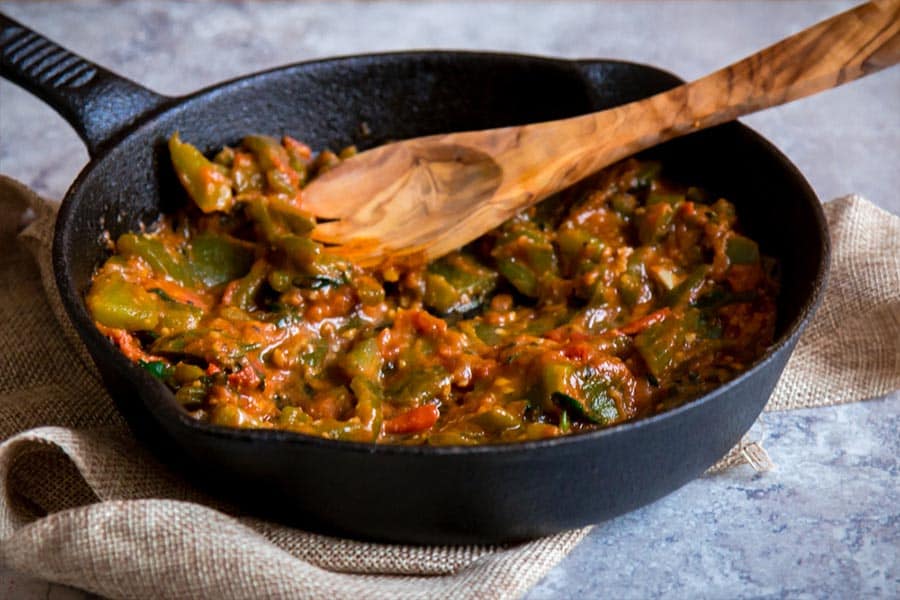
-
Zaalouk
If you’ve never tried Zaalouk, you’re missing out on a truly flavorful and unique experience. This Moroccan dip is made from eggplant, tomatoes, garlic, olive oil, and spices like cumin, paprika, parsley, and cilantro. It’s perfect for dipping crusty bread or as a side dish to Moroccan meat, chicken, or meat dishes.
The best versions of Zaalouk are made with roasted eggplant. This adds a beautiful smokiness and another layer of flavor to the dish. If you’ve never tried Zaalouk before, you’re in for a real treat!

-
Maakouda
The delicious Maakouda potato patty is made with fried mashed potatoes mixed with sautéed onions, cilantro, garlic, and cumin.
Maakouda is enjoyed in many ways. It can be eaten as an appetizer, a side dish, or a sandwich filling. Maakouda becomes especially popular during Ramadan and is often served as street food in Morocco.
-
Briouates
Delightful triangles and tubes of indulgence, Briouats are a Moroccan delicacy made with delicate Warqa pastry. Whether fried or baked to golden perfection, they come in sweet and savory varieties – an ideal treat for any occasion! Deliciously wrapped parcels bursting with flavor.
The Briouates recipes vary, but they’re mainly made with beef or chicken, cheese, onions, and different spices and herbs like cilantro, parsley, cumin, paprika, cinnamon, and pepper.
Lusciously sweet almond Briouats are a traditional Moroccan delicacy encrusted in warm honey and sesame seeds. These delectable treats come filled with fragrant almond paste imbued with cinnamon and orange flower water. During Ramadan, families across Morocco whip up batches of the tasty morsel to enjoy together over tea alongside other classic desserts like Chebakia or Sellou (roasted flour dessert).

Breads & pancakes
-
Khobz
Bread is not just a food in Morocco but a way of life. It is consumed at almost every meal and serves both as sustenance and as a utensil for scooping up Moroccan Tagines, dips, salads, Tagines, entrees, and side dishes. A day spent in this North African country quickly reveals how hearty bread is to Moroccan cuisine and culture.
There are countless sorts of bread in Morocco, yet the most famous is this round-shaped one named Khobz. Usually alluded to as force, alluding to the French expression for solid white flour, Khobz is a circle-shaped kind of crunchy pale bread with an unpleasant inside and surface. However, it’s a flexible everyday loaf that can be utilized as a scooper for Moroccan dishes or a container for flame-broiled meats and other sandwich fillings!
Bakers in Morocco typically make their Khobz loaves between 1.5-3 cm thick, slightly thicker than your average flatbread. However, many Moroccans prefer their Khobz to be thinner (0.6-1.3 cm). This personal-sized loaf can be baked into a large family-size round measuring 30 cm across or into smaller individual rounds.
Even though Khobz is readily available at neighborhood bakeries and shops, many Moroccan families still prefer to make it from scratch. So they’ll bake it in Ferran (communal wood-fired ovens) or in-home ovens.
. Homemade Khobz tastes better and is more nutritious than store-bought bread. Plus, it’s a great way to bond with family and friends while making something useful.
Bread is essential to the Moroccan diet, eaten for breakfast, lunch, and dinner. Khobz bread is often served with honey and soft cheese or dipped in olive oil. It is the perfect accompaniment to soups and tagines. In Morocco, bread is considered sacred and is rarely wasted or thrown out.
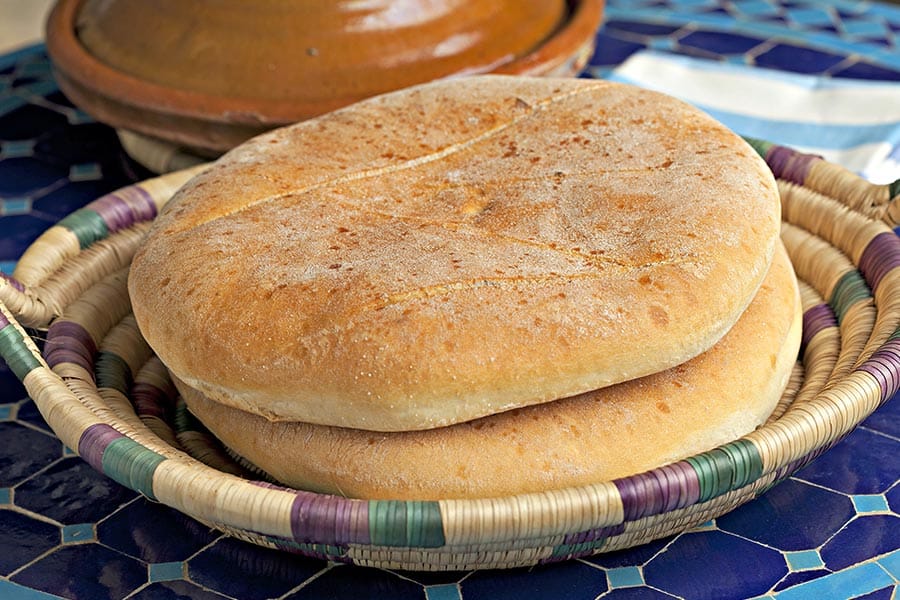
-
Batbout
Moroccan flatbread, Batbout, is a delectable combination of semolina, white flour, and whole wheat flour. It’s cooked on a stove instead of baked in an oven like traditional Middle Eastern pita bread. This makes it a healthier option and gives it a unique flavor.
Versatile and delectable, Batbout is a bread that can be crafted into different shapes. It boasts an internal pocket perfect for presenting sandwich fillings; it’s also delicious when served as breakfast with butter, honey, or jam – the ideal accompaniment to grilled meat dishes!
-
Msemen
If you’re a fan of crepes or pancakes, then Msemen is sure to be your favorite! This delectable thin flatbread with multiple layers – commonly eaten in Morocco, Tunisia, and Algeria- makes for an excellent breakfast or street food option. A taste sensation from the Maghreb region that’s not to be missed!
Mouthwatering and time-honored, Msemen is crafted from a mixture of flour, durum wheat semolina, buttery spread, desiccated yeast flakes, saltiness, sweetness, and liquid. Shaping the dough into spheres and then rolling it out into thin disks before folding them square produces this delectable treat that, when flattened with your palms, becomes even more appetizing as it crisps on both sides in a skillet or frying pan until turning golden brown.
Msemen is a tasty delicacy that can be either savory or sweet. Commonly enjoyed for breakfast, this delightful morsel accompanies your morning cup of tea or coffee. Then, dip another notch in hot honey and butter sauce! Savory options are also available; these Msemens may be filled with delectable ingredients such as ground meat (preferably beef/lamb), onions, herbs, and spices.
In Morocco, you’ll find bakeries selling freshly-made Msemens alongside street food stalls serving them too. However, many Moroccans still prefer home cooking when making treats like this!

-
Meloui
If you’re looking for a delicious and unique pancake or crepe, try Meloui! This Moroccan dish is very similar to Msemen, but the main difference is in its shape. Meloui is rolled into a coil or roll before being flattened and cooked, while Msemen is formed into a square. So if you’re looking for something new to try, give meloui a taste!
Another difference between meloui and mMemen is the amount of semolina used to make them. This gives them different tastes and textures and affects how they are eaten. When made correctly, meloui can be pulled from its edges and uncoiled towards the center. Like Msemen, it is typically eaten for breakfast with honey and butter or as a snack with tea.
-
Baghrir
If you’ve never tried Baghrir pancakes, you’re in for a treat. These small, spongy cakes get their name from the thousands of tiny holes that form during the cooking process. They’re absolutely delicious, and you will only get enough of them once you’ve tasted them.
In Morocco, Baghrir pancakes are made with a crepe-like batter of flour, fine semolina, baking powder, yeast, salt, and sugar. Water is also added to the mixture to create holes throughout the pancake. The addition of yeast makes these pancakes light and fluffy. At the same time, the baking powder provides them with a subtle flavor that pairs well with savory or sweet toppings.
Once the batter touches down, a plethora of bubbles emerge and splinter across the Baghrir’s surface as it sizzles. Unlike western pancakes, this Moroccan delight is only cooked on one side, making its preparation effortless and efficient!
Baghrir pancakes are delicious when paired with honey-butter syrup, making them a perfect breakfast food. They’re also a common p of iftar meals during Ramadan. The holes in the pancakes may put some people off, but they actually help to trap and absorb the syrups and jams, making them even more delicious. So don’t let the holes deter you from trying this traditional dish!
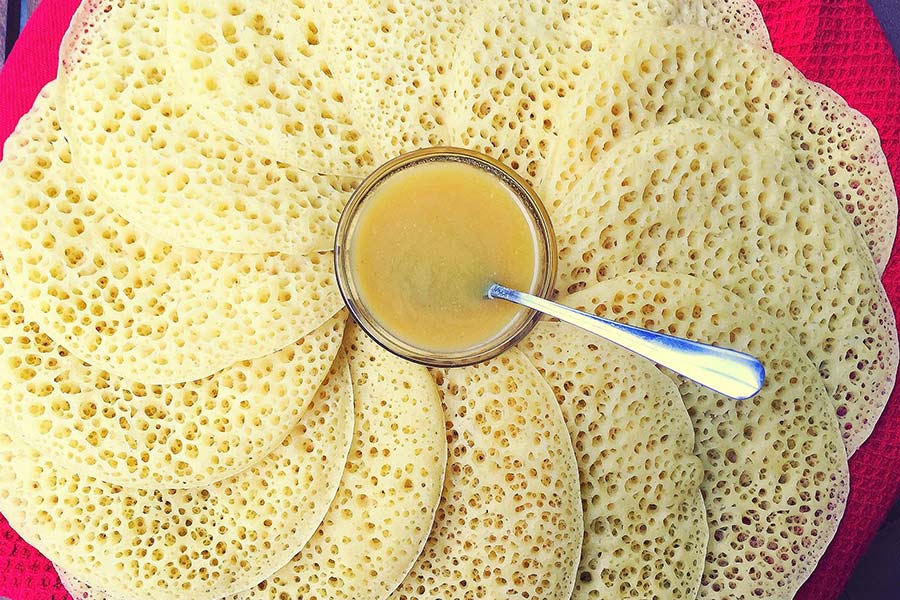
-
Moufleta
Did you know North Africa is where the second-largest Jewish diaspora population resides? Moroccan Jews Jews have had a presence in the region for more than two thousand years, which predates Sephardic Jew’s arrival. They maintain their customs and celebrations, one of which is Mimouna.
Mimouna is a grand festivity observed the day succeeding Passover in areas encompassing ample Moroccan Jewish society. This momentous celebration commemorates the return to consuming hametz, which includes foodstuffs containing leavening agents such as yeast-raised bread, flapjacks, and biscuits – all of these are forbidden during Passover.
Moufleta is a timeless classic featured in Mimouna festivities. This Moroccan Jewish pancake made of flour, water, and oil has been enjoyed for centuries! It is served to steam hot with sweet accompaniments like butter, honey, or syrup alongside crunchy nuts & dried fruits. This traditional treat will tantalize your taste buds!

-
Harcha
Harcha is a type of pancake or pan-fried bread made with semolina. It’s popular in Morocco and Algeria because of its coarse and crispy exterior derived from semolina.
Harcha is a delicious and easy-to-make dish consisting of semolina, butter, milk, salt, sugar, and baking powder. The dough is shaped into balls, rolled in coarse semolina, and then formed into rounds. They are cooked on a grill on both sides until they are light golden brown. Harcha can be made into small cakes or giant games to share with others.
When cooked, Harcha resembles English muffins though it tastes more like cornbread. It’s typically eaten for breakfast or as a snack with mint tea, jam, cheese, or honey-butter syrup. Like Baghrir, it’s popular during Ramadan as a snack.
-
Krachel
Krachels are the perfect breakfast food! They’re sweet, fragrant, and full of flavor. Plus, they’re easy to make. Just mix a yeasted brioche-like dough with aniseed and orange blossom water. Then brush it with egg wash and dust it with sesame seeds. Finally, bake it to a deep golden brown, and enjoy!
Because krachel is commonly eaten for breakfast or as a snack with Moroccan tea, it can be part of a breakfast meal during Ramadan. In addition, this bread is often eaten with butter, jam, or cheese for a delicious and satisfying dinner.

Meat, poultry & Seafood
-
Tagine
Following Couscous, a standout in Moroccan culinary culture is the Tagine. This delectable delight can indicate either the savory Berber dish or its distinctive and often vibrant cooking vessel – named tajin by locals, which translates to “shallow earthen pot .”An outstanding addition to any meal!
Referring to the cookware, a tagine (or tajin) is an embodiment of two components – a flat, round base for both cooking and serving purposes, as well as its characteristic conical lid. Coming in various sizes and are available with or without glazing. Cooks most favor unglazed tagines due to their ability to infuse dishes with earthy flavors.
The Tagine’s cone-like shape is designed to steam the meat and return moisture to the dish cooking below. This saves water needed to simmer tough cuts of meat and make them tender. Not only does it keep the food as moist and tender as possible, but it also conserves water in areas where resources are limited. Not only does it keep the protein as juicy and delicate as feasible, but it is also a wise technique for preparing in places where water sources are kept to a minimum.
A Tagine is a perfect vessel for slow-cooking Moroccan stews made with various meats, poultry, fish, vegetables, and fruit. The unique shape of the Tagine allows heat to circulate evenly, resulting in tender and succulent dishes full of flavor. Typical spices used in tagines include turmeric, saffron, paprika, cumin, cinnamon, and ginger, giving these dishes their characteristic sweet and sour flavor profile. In addition, fresh herbs are often added to recipes with other ingredients like olives, preserved lemon, nuts, or dried fruit to create truly memorable meals.
This Kefta tagine is an exquisite and celebrated fare prepared with spiced beef or lamb meatballs simmered in a zesty tomato sauce. When it’s served alongside Moroccan bread, the experience improves as you can poach eggs directly into this savory dish!
No matter what it’s made of, Tagine is one of the best dishes you can try when on a Morocco tour. You absolutely cannot leave Morocco without trying it at least once!
-
Kebabs
Grilled succulent meat skewers are a staple in many cultures, including Morocco. Exquisite Qotban is crafted with lamb or beef marinated to perfection utilizing onions, parsley, olive oil, and spices like salt and pepper. Fat cubes are interspersed between chunks of protein on each skewer before it is signed over a hot charcoal fire.
When crafted with savory minced beef or sheep, this delicacy is termed Kefta (or kofta) kebabs.
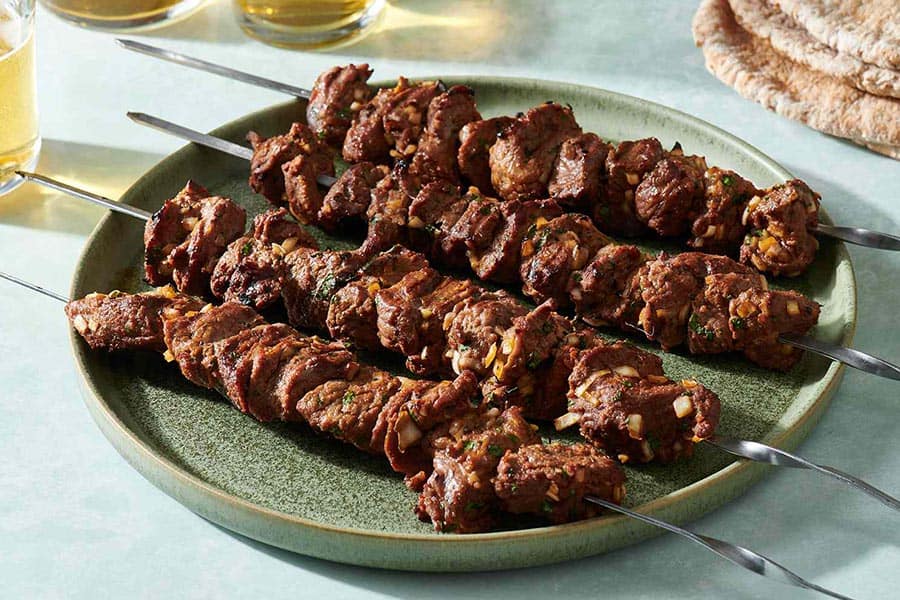
-
Bastilla
Bastilla is a delicious and popular dish in Moroccan cuisine. It refers to a savory pie made with light and crispy warqa dough. The pie can be filled with either poultry or Seafood and is originally from Andalusia. The name Bastilla comes from the Spanish word pastilla, which means “small pastry.” This dish is a must-try for anyone who loves savory pies!
Aromatic Chicken Bastilla is a classic Moroccan dish of the highest caliber. Tender chicken is browned to perfection in butter before being simmered with onions, parsley, and exotic spices like saffron, nutmeg, and ginger until succulent. Afterward, it’s deboned and shredded to create an exquisite filling for this savory pastry with its custard-like sauce achieved when eggs thicken up the reduced simmering liquid – delicious!
In a circular skillet, delicate layers of butter-fried warqa dough are interspersed with savory sauce and shredded poultry. A layer containing crumbled almonds blended with sugar and cinnamon is included before being enclosed in more levels of greased warqa pastry. The pie is cooked until it obtains a delicious golden hue; finally garnished with powdered sugar, cinnamon, or toasted almonds for extra sweetness before serving!
Unlike the chicken Bastilla, whose sweet and savory taste combination, the seafood Bastilla is known to be fiery. This dish features a blend of fish, squid, and prawns mixed in with vermicelli noodles and black mushrooms, plus an incendiary tomato sauce.

-
Chicken Rfissa
Nourishing food is vital for new mothers, and chicken Rfissa is the perfect example. This dish, made of stewed chicken, lentils, and onions served on top of shredded Trid pastry, is a popular Moroccan Berber meal given to new mothers on the third day after childbirth due to its many health benefits. If you’re looking for a nutritious and hearty meal to help you recover post-delivery, look no further than chicken Rfissa!
Chicken Rfissa is a hearty, flavorful dish perfect for a chilly winter. The chicken and lentils are stewed with fenugreek seeds, Ras el Hanout, saffron, and other spices and served over a shredded and steamed trid pastry. It’s filling and satisfying and the perfect comfort food to warm you up on a cold day.
Chicken Rfissa is lauded as a godsend to recently delivered mothers, thanks to its inclusion of fenugreek seeds. This uncommon herb has been utilized in traditional medicine for centuries. In addition, it is thought to bring a bounty of health advantages postpartum.
Chicken Rfissa is a traditional dish prepared for new mothers and a delicious and popular meal that can be enjoyed on other occasions and at family gatherings.
-
Fish chermoula
Chermoula is a fragrant, flavorful marinade or relish used in North African cooking. It’s traditionally used to add flavored fish and seafood dishes but can also be used on meats, poultry, and vegetables. Chermoula is simple to make and adds a delicious depth of flavor to any dish.
There are limitless ways to make chermoula, but the classic ingredients include garlic, salt, olive oil, fresh herbs, and spices. Common additions to this recipe vary by region. However, some popular options include black pepper, coriander, parsley, cumin, paprika, Harissa, and turmeric.
-
Fried stuffed sardines
Morocco, situated on the northwestern coast of Africa, has a coastline of 3,000 km (1,864 mi), making it ideal for fishing and seafood production – sardines being one of the most important catches.
Sardines caught in Moroccan waters make up more than 62% of the country’s total fish catch. This amounts to around 600,000 tons of sardines being processed yearly – making Morocco the world’s largest exporter of canned sardines.
Sardines are an incredibly abundant fish, making them an inexpensive and accessible food source, especially for families living in coastal areas of Morocco. Not to mention, they’re a staple ingredient in many Moroccan dishes – one of the most popular being fried sardines stuffed with chermoula. So when it comes to healthy and delicious SeafoodSeafood, it’s hard to beat sardines.

-
Babbouch (Moroccan snail Soup )
If you savor Vietnamese ốc, then why not try Babbouche? This delicious Moroccan street food is made with snails immersed in a flavourful spiced broth. It’s sure to tantalize your taste buds!
From vendor to vendor, recipes for Babbouche (or Ghlal) can vary greatly. But this delicious snail soup is commonly flavored with up to fifteen different spices like licorice root, aniseed, thyme, lavender, and tea leaves. Served in a bowl with broth, it’s the perfect winter dish!

Deserts & drinks
-
Chebakia
Chebakia is a deep-fried Moroccan sesame cookie known for its floral shape and crunchy texture. It’s traditionally prepared during the month of Ramadan.
Chebakia is a delicious and unique treat that is perfect for any occasion. Made from strips of spiced sesame dough that are rolled into rose shapes, these cookies are then deep-fried till golden brown and crunchy. They’re then coated with a delicious honey and orange blossom syrup and sprinkled with sesame seeds. You’ll love the crispy.
The process of making Chebakia can be time-consuming. As a result, Moroccan women often work together to create large batches, which they then divide amongst themselves to last through Ramadan.
It is traditional to serve Chebakia to break the fast during Ramadan. Still, it is often prepared for other special occasions as well.

-
Sellou
Like Harira and Chebakia, Sellou is one of Ramadan’s most commonly eaten dishes. This unique Moroccan dessert is made from roasted flour mixed with honey, butter, fried almonds, toasted unhulled sesame seeds, and spices.
To prepare Sellou, the ingredients are combined to form a thick, rich paste. This paste is then formed into a pyramid shape and decorated with almonds. To serve individual portions are cut from the pyramid and served on plates.
Sellou is a fantastic dish because it is so nutritious and calorie-packed. Nursing mothers are advised to consume sellou for at least thirty days after giving birth because it is considered a natural dietary remedy that can increase lactation.
-
Kaab Elghzal
The alluring Kaab el ghazal is often seen at Moroccan celebrations and festivals. These crescent-shaped treats get their name from “gazelle ankles” but are more commonly known as “gazelle horns ”Delicious and buttery, they melt in your mouth with every bite. Be sure to try some the next time you have a chance!
Gazelle horns are a delectable pastry with flour-based dough filled with almond paste, cinnamon, and orange blossom water. Baked to perfection and then dipped in orange blossom water, these pastries are dusted with powdered sugar to create the perfect sweet treat known as Kaab el Ghazal M’fenned.

-
Ghriba
Ghriba cookies are a delicious and traditional treat from Morocco. They are made with ground almonds and toasted sesame seeds and come in various varieties. Ghoriba Bahla is a trendy type of Ghriba known for its distinctive cracked surface. These cookies are perfect for any occasion and will please everyone who tries them!
The imperfections and accidents in Ghriba cookies are highly desirable. These fissures signify that the biscuit was crafted with the precise proportion of ingredients and therefore has the required consistency. These cracks are necessary for a cookie-toled Ghriba, not Ghriba Bahla.

-
Kaak Essaouira
Named for the stunning seaside city of Essaouira, Kaak d’Essaouira is a delightful Moroccan cookie crafted with flour, aniseed, sesame seeds, and fragrant orange blossom water. Delicately sweetened with sugar and vanilla, then seasoned to perfection using salt; this vegan treat has become popular street food throughout Morocco!
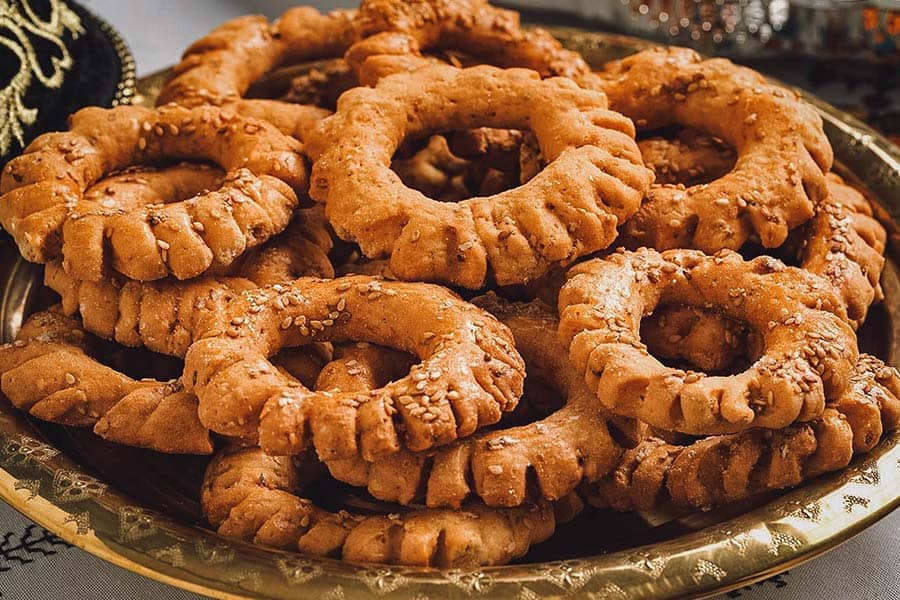
-
Sfenj
Doughnuts are a delicious and popular dessert in many cuisines, including Moroccan. Sfenj is a type of Moroccan doughnut made from sticky unsweetened leavened dough. These chewy and fluffy treats are popular street food in Morocco. You can eat them plain, sprinkled with sugar, or dipped in honey.
Sfenj is presumed to have its roots in Andalusia, and rumor is that they were the source of motivation for French beignets. These treats spread far and wide from North Africa – even being consumed by Moroccan Jews or Sephardic people at Hanukkah festivities.

-
Mint tea
If you want something to accompany these tasty Moroccan treats, then opt for mint tea – a popular beverage from Morocco made with green leafy tea, spearmint, and sugar. This traditional drink is an integral part of social life in the Maghreb region. It brings out all that’s great about this cuisine!
Making Moroccan mint tea is an important ritual steeped in history. As the head male of the family, I am responsible for making this delicious beverage and offering it to guests as a sign of hospitality. Pouring the tea from a height creates gentle aeration, which improves its flavor.
Mint tea is a social event in Morocco, enjoyed throughout the day. It’s brewed three times and served in glasses that have different flavors depending on how long the tea steeps.


Morocco food tours
A food tour is the best way to experience all that Morocco has to offer in terms of intoxicating flavors and aromas. You’ll be able to try new dishes, learn about different ingredients, and get a feel for the city’s culinary culture. Plus, a knowledgeable guide will be there to explain everything along the way.
Morocco cooking workshops
If you want to learn more about Moroccan cuisine, then taking part in a cooking workshop is one of the best ways to do it. You’ll be able to see how the dishes are made and get a better understanding of the ingredients and flavors used. Plus, it’s a great way to meet new people and learn about the culture. Our Morocco cooking class at La Maison Arabe is the perfect way to immerse yourself in Moroccan food.
Final thoughts on Morocco food
Morocco is the perfect place for you if you’re looking for an immersive and exciting travel destination. Its many souks, spices, and medinas feast on the senses. You’ll be captivated by the intoxicating blend of sights, smells, and sounds. And if you’re a foodie, you’ll be especially thrilled by the unique flavors of Morocco.
This is a partial guide to the foods of Morocco, but we hope it gives you a taste of what this amazing country has to offer. From traditional dishes like Couscous and Tagine to sweet treats like Chebakia, there’s something for everyone in Moroccan cuisine. So why not start exploring today?
